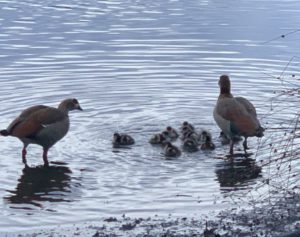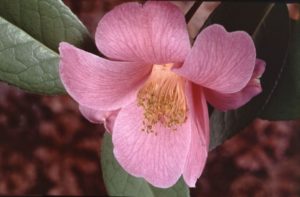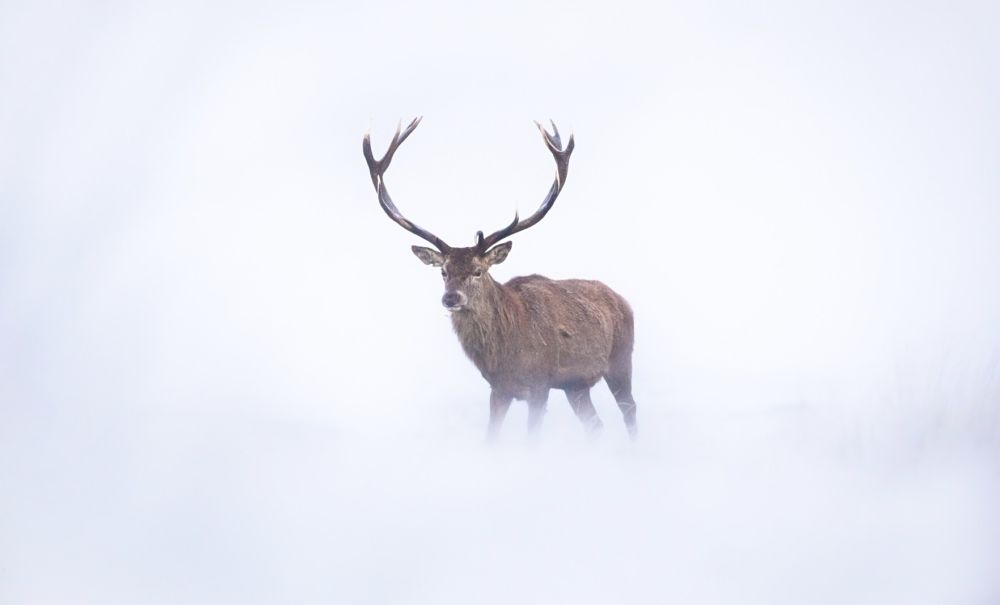Photo: ‘Deer from the mist’, by @DaniConnorWild on Instagram
Deer Cull and car park closures .
A reminder that the deer cull started this week and will last for 4-6 weeks. Also, in the Spring some of the car parks will be closed for repairs – exact dates still to be decided – scroll down to TRP’s Richmond Park Diary for more.
Ranger applications close 9 February!
If you’re interested in becoming a Volunteer Ranger in Richmond Park or Bushy Park you have only a few days to apply. Full details on our website here
Legal support for Heathrow campaign
This is a request to all members. We would like to hear from anyone with legal expertise in environmental and/or infrastructure planning law, who could help the Friends, on a voluntary basis, with our campaign against proposed new flightpaths over Richmond Park. We have had a number of meetings with Heathrow representatives and, as our campaign progresses, we feel that a person with professional knowledge of the law, in this area, would be an asset to the team. Please contact chairman@frp.org.uk
Photo competition: Trees of Richmond Park in Winter – Closes 29 February
There’s still time to enter the winter photo competition.
Last few weeks to take and submit your photos of the Parks’ trees in winter. Fortunately, snow, ice, frost and mist are not needed to take stunning photos of trees in all their winter splendour! Full details here of how to enter, the prizes and Terms and Conditions.
Visitor Centre News
- The Visitor Centre will be closed 24 – 28 February. We are refurbishing the floor of the Visitor Centre to give it a fresh new look. Work will commence Monday 24 Feb and finish Friday 28 Feb. Open as usual on Saturday 29th.
- Tree walk packs selling fast. Have you got yours?
- Royal Oak mini prints 35cm x 28cm available now!
- Beeswax food wraps made from beeswax from bee hives in Richmond Park are now in stock (£12) for 3 wraps.
- NEW Royal Oak Tea towel £7 – in stock this month.
- Richmond Park honey is back in stock – small and large jars of both runny and set.
Tree conservation projects
Some new tree conservation projects have been completed, with funding from the Friends and sales from the Visitor Centre.
- In December, fencing was installed around the blackthorn enclosure opposite Broomfield Hill car park; the enclosure of two gorse areas to the east side of Conduit Wood had already been completed. Painting of the metal fencing will be done in the spring.
- Seven veteran trees have been fenced with chestnut railings – a group of five oaks east of Thatched House Lodge and two oaks alongside the road near Robin Hood Gate. A further 12 are being protected during February/March.
- Planting of 40 crab apple, wild pear and damson treeshave been planted at various locations across the Park. Nectar-rich blossom attracts invertebrates and fruit feeds birds, deer and other mammals.
15 million trees destroyed in just one hour!
This horrifying statistic was reported in a short BBC video by Tony Kirkham, Head of the Arboretum, Gardens and Horticultural Services at Kew Gardens. (He’s the one who gave the fascinating and entertaining talk at our Year of the Tree launch in Pembroke Lodge back in November). It was in the great storm of October 1987 when some 15 million trees were felled, in the space of one hour, in the South East of England alone. To find out more and how trees are looked after, see the video here.
In the video, Tony talks mainly about Kew Gardens, but Richmond Park also lost a lot of trees in the 1987 storm, including most of, the now replanted, Two Storm Wood (hence the name – two storms in 1987 and 1990). Richmond Park, like Kew, has a great concern about compaction of tree roots by visitors’ feet, making them vulnerable to high winds, and many trees, especially the veteran oaks (which are all older than Kew’s Turner Oak), are now being fenced to protect them.
Richmond Park Police Panel.
Richmond Park has its own police liaison group, the Safer Parks Police Panel (SPP), similar to the Police Liaison Groups in your residential neighbourhood. It monitors and scrutinises police performance and sets policing priorities. The SPP comprises 15 people representing local interests, and meets quarterly, with the police and local park management attending ex-officio.
Whilst conventional crime is low and the park is very safe, it has specific local wildlife and ecology protection issues, often seasonal, such as skylark protection and ensuring dogs are on leads around Pen Ponds. Speeding on the roads is also an issue. The biggest problem that the police have to deal with is deer harassment, and these are their statistics for Oct-Dec 2019:
Deer Harassment verbal warnings (Richmond Park)
- 301 warnings to public – too close etc.
- 7 to dog owners – dogs worrying deer, including one owner ejected from the park.
(A deer had to be put down in Bushy Park a few days ago following injuries from a dog attack).
We hope to report regularly on policing and safety issues in the park.
Star Count 2020 in Richmond Park 21-28 February
Want to get involved in the star count? People from all across the country are becoming ‘citizen scientists’ for a week. Join in by choosing a clear night between 21 and 28 February 2020 and counting the number of stars you can see within the constellation of Orion. See full information here.
N.B. The cull will be in full swing so you must remember to be out of the Park by 8pm to avoid being locked in.
Royal Parks receives further £750k boost to protect wildlife.
A project to protect and increase wildlife across the 5,000 acres of London’s Royal Parks has received a £750k boost, thanks to the People’s Postcode Lottery. The new award will allow The Royal Parks’ Mission: Invertebrate project to continue for a fourth year during 2020. Launched in 2017, Mission: Invertebrate supports wildlife across the Royal Parks by helping ‘bugs’ such as bees, butterflies, beetles, worms, slugs and snails to thrive. More information on Mission: Invertebrate
Royal Oak prints a fundraising success
The limited edition of 100 signed prints of Mark Frith’s Royal Oak – our symbol for Year of the Tree – has sold out and raised over £38,000 in sales, all net proceeds of which go to tree conservation projects in the Park. Many people who contacted us to purchase a print, after seeing a feature about Mark and the Royal Oak in local residents’ magazines, were disappointed but we’re pleased to say there are still plenty of the smaller prints available exclusively at the Visitor Centre by Pembroke Lodge.
Funds raised by sales of all prints and other Royal Oak and Year of the Tree merchandise are going into the Friends’ £100,000 fund for tree conservation carried out by Park management. Already, a lot of work is under way which will contribute to, and help to protect, the Park’s rich biodiversity.
Beverley Brook improvements
If you’re near Roehampton Gate over the next few weeks, you may see some works on Beverley Brook at the confluence with the stream from Pen Ponds (near the road bridge), which are just being completed, after two years delay. A backwater is being created to help with fish spawning and the stream from Pen Ponds improved to give a better habitat. This is again partly funded by the Friends and sales from the Visitor Centre.
Beverley Brook clean up
You may be aware that, apart from our Adopt an Area volunteers, who are doing a splendid job helping to keep our Park pristine and free from litter, there is a small group of volunteers also doing a splendid job removing rubbish from Beverley Brook. They are kitted out with full waders and use floating ‘litter dinghies’ to collect the rubbish. On a recent outing they described what they found as ‘a plague of plastic in all its forms’, plus a wide range of other discarded items. The source of some of the litter is unfortunately from outside, as well as inside the Park, as it gets carried along from further upstream. A never ending task!
VACANCIES for horticultural apprentices
The Royal Parks is looking for 7 horticultural apprentices. Successful applicants will be based in one of London’s eight Royal Parks four days a week, and study at Capel Manor College in The Regent’s Park on the remaining day. The apprentices will be employed by one of The Royal Parks’ landscape maintenance contractors. See testimonies from current apprentices.
Applicants need to be over 16. There is no upper age limit
Deadline for applications is 15 March 2020. Full details and how to apply.
Newton’s Saplings
Bushy Park has been chosen to be the home of one of eight ‘space saplings’. The tree is derived from the pips of Isaac Newton’s apple tree that were blasted into space with British astronaut Tim Peake in 2015. Read more.
A helping hand
Visitors to Richmond Park may be familiar with the sound of Egyptian Geese calling from the treetops or as they fly past, but not so aware that as some of us were celebrating the New Year, these intrepid birds could be halfway through laying a dozen or so eggs in the safety of a suitable tree cavity. Out for his usual pre-dawn amble around Pen Ponds, Bird Group member Steve Read heard a commotion coming from the direction of Queen Elizabeth Plantation, where he found two adult birds trying to lead a brood of newly hatched goslings down to the relative safety of water. Life is tough from the moment they leap from the sanctity of their tree top cavity, these youngsters had already attracted unwanted attention and were being picked off by the Crows, and a passing Kestrel swept down and took one also. It can be very harrowing to watch.
Steve carefully shepherded the family down to the Upper Pen Pond Sanctuary. Then realising something was still attracting the attention of the Crows back by Queen Elizabeth Plantation a quick search revealed a further five chicks scattered about. He scooped them up, sticking them in any available pocket, took them down to the sanctuary and launched them gently in the direction of slightly bemused parents. They all gathered in a huddle at the water’s edge, safe for the time being.

Events Calendar
Next 3 months
WALKS
All are welcome to join our walks. Start at 10.00am from the designated car park.
- 07 Mar Kingston Gate Car Park
- 04 Apr Sheen Gate Car Park (+ Walk the Wall)
TALKS & WALKS – Friends’ members only. (New members – join here)
Start at Pembroke Lodge at 10.15am, unless otherwise stated. No need to book – just turn up. Coffee/tea provided. The talks are usually 45-60 minutes, followed by an optional 90 minute walk, unless otherwise indicated.
- 15 Feb Birds of Richmond Park by Peter Burrows-Smith (talk and walk)
- 21 Mar Trees of Richmond Park by Simon Richards and Gillian Jonusas
- 28 Mar YOTT Tree Walk, led by Christopher Hedley (from Pembroke Lodge)
- 25 Apr YOTT Tree Walk (from Broomfield Hill Car Park)
Richmond Park Diary – February 2020
©TRP / PAC. 03/02/2020
Dog walking
Richmond Park is unrivalled in London as an extensive area of rolling countryside – ideal for walking a dog and with nearly 25% of households owning a dog it’s a popular activity! Legally all dog owners should ensure that their dogs are micro chipped AND wear a tag with a mobile phone number, and need to train their dog so that they are safe to encounter deer, horses, other dogs and park users. It’s best to attend dog training classes before visiting the park and gradually build on experiences as the training progresses. Special attention should be taken to train a dog to recall before going off lead and be safe with deer and the park roads.
National Nature Reserve (NNR)
NNR is a designation made under the Wildlife and Countryside Act that recognises and protects the UK’s nationally important habitats. There are just 224 NNRs in England, totalling 94,400 hectares which is approximately 0.7% of the country’s land surface. So, any site designated as an NNR is exceptionally special for wildlife and most NNRs offer great opportunities for the public to experience wildlife at first hand and to learn more about nature conservation. Richmond Park at 1000 hectares is one of the very largest – there are 10 or so sites larger but all of these are in very remote locations and the habitats are inaccessible for many people – such as tidal grazing marsh or mudflats. When we consider the park’s location – it’s no surprise that it receives as many visitors as the 163 NNR’s managed by other government bodies put together – making Richmond Park the most popular, by a country mile!
Litter – Not such a new problem!
One of the volunteer litter pickers recently noticed a comment in a book called ‘Round the year in Richmond Park’, published in 1923, that reads as follows “…an appeal is made to those who enjoy the sight of the wild life of the park to do all in their power to preserve its natural beauties unspoiled. The regulations of H.M. Office of Works strictly prohibits the disturbance of animals and birds, the gathering of flowers, damage to the turf or tree etc. ; and of late special notices have been issued against the vulgar and untidy practice of leaving paper bags, tins, bottles, or other picnic litter lying about on the grass. The park officials are as vigilant and they are courteous; but they cannot be everywhere, and it is incumbent on all who come to the park for pleasure to avoid, not only destruction, but also untidiness, which spoil so effectively the enjoyment of others”.
Car park repairs
Richmond Park has 7 main carparks and 1 small disabled only parking at Isabella Plantation providing a total of around 1500 free parking spaces. (There are also c.150 parking spaces for the golf course, just off the A3). Only 3 car parks are fully surfaced, 2 are part surfaced and 3 are unsurfaced. Maintaining unsurfaced car parks is very difficult and potholes are a perpetual problem – especially when it’s wet. This spring The Royal Parks are planning to complete such much-needed improvements and are currently exploring the scope of works and costs. The car park(s) will need to close whilst work is completed, but we trust visitors will appreciate the improvements.
Isabella Plantation in February
Heather Garden
Erica x darleyensis comes into flower in its pink and white forms. Tawny seed heads of Erica vagans remain decorative all winter. The tall “Portugal Heath“, Erica lusitanica, bears slightly fragrant tubular white flowers opening from pink buds throughout winter.
Clumps may be found towards the top of the Heather Garden, near the junction of Thomson’s Stream and the Main Stream.
Nandina domestica “Sacred Bamboo”, is planted behind the heather in several places, is truly a plant for all seasons. Decorative evergreen leaves are tinged purple in spring and autumn, panicles of white flowers open in the summer to provide orange red berries throughout winter.
Flowering shrubs
Hamamelis mollis, the “Witch Hazel”, has fragrant yellow tassel flowers. Two large shrubs stand by the gate to Broomfield Hill.
Lonicera X purpusii ‘Winter Beauty’ is a shrubby honeysuckle which bears tiny white fragrant flowers throughout winter. A group of these shrubs grows by the Acer Glade path.
Rhododendron dauricum ‘Midwinter’ is a semi–evergreen or deciduous Rhododendron which grows on Bluebell Walk and looks stunning this month with its phlox purple flowers.
Rhododendron ‘Christmas Cheer’ flowers pink in bud and fades to white grows alongside the main stream path above the Bog Garden. The name refers to the one time practice of forcing this plant for decoration.
Camellia japonica ‘Nobilissima’, with white peony form flowers grows in the woodland ride to the north of Thomson’s Stream.
The williamsii hybrid Camellia ‘Parkside’ bears an abundance of semi-double flowers in a clear pink and can be found growing in the glade next to Thomson’s Lawn. Many other Camellias are beginning to flower around the gardens.
Cornus mas the “Cornelian Cherry” grows in the shelterbelt near the gate to disabled car park. It produces lots of small yellow flowers on the naked stems throughout February.
Look out for the daffodil Narcissus cyclamineus growing naturalised in the lawns to the left of the Top Gate which bare delicate rich golden pendulous flowers.
You can see photos of the plants mentioned here on the Royal Parks website.
Isabella Plantation Walks
February
Fri 7th & 28th
Sun 16th
March
Fri 6th & 27th
Sun 22nd
Walks last about one and a half hours and are free of charge.
Meet inside the Garden by the gate from Broomfield Hill car park at 11.00a.m.

Camellia x williamsii ‘Parkside’ Grandiflora Bay


